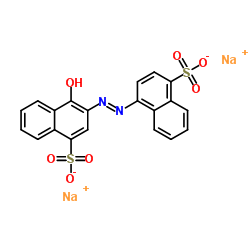

铬变素FB结构式

|
常用名 | 铬变素FB | 英文名 | Carmoisine |
|---|---|---|---|---|
| CAS号 | 3567-69-9 | 分子量 | 502.428 | |
| 密度 | N/A | 沸点 | N/A | |
| 分子式 | C20H12N2Na2O7S2 | 熔点 | >300ºC | |
| MSDS | 中文版 美版 | 闪点 | >225℃ | |
| 符号 |

GHS07 |
信号词 | Warning |
|
Determination of vanadium in groundwater samples with an improved kinetic spectrophotometric method.
Environ. Technol. 35(9-12) , 1165-74, (2014) A kinetic catalytic method has been developed for the determination of vanadium based on its catalytic effect on the redox reaction of azorubin S and bromate in the presence of a sulphuric and nitric acid mixture. The reaction is monitored spectrophotometrica... |
|
|
Toxic effects of some synthetic food colorants and/or flavor additives on male rats.
Toxicol. Ind. Health 29(2) , 224-32, (2013) The objective of the present work was to evaluate the broadest toxic effect of some synthetic additives of colorants and/or flavors on different body organs and metabolic aspects in rats. A number of chemical food color and flavor additives are routinely adde... |
|
|
Pattern of intake of food additives associated with hyperactivity in Irish children and teenagers.
Food Addit. Contam. Part A. Chem. Anal. Control. Expo. Risk Assess. 27(4) , 447-56, (2010) A double-blind randomized intervention study has previously shown that a significant relationship exists between the consumption of various mixes of seven target additives by children and the onset of hyperactive behaviour. The present study set out to ascert... |
|
|
Estimates of dietary exposure of children to artificial food colours in Kuwait.
Food Addit. Contam. 23(3) , 245-51, (2006) To assess the intake of artificial food colour additives by 5-14-year-old children in the State of Kuwait, a 24-h dietary recall was conducted twice on 3141 male and female Kuwaiti and non-Kuwaiti children from 58 schools. The determination of colour additive... |
|
|
Microbiological research on soft drinks: discolouring of natural-flavoured products.
Zentralbl. Mikrobiol. 147(1-2) , 51-60, (1992) The results of experiments testing the effects of yeasts, sunlight, and temperature on the food dyes tartrazine, ponceau 4R, indigotin and azorubin (used for colouring ginger soft drink) are reported. Light was found to exert a greater influence than heat, an... |
|
|
Toxicity of tomato red, a popular food dye blend on male albino mice.
Exp. Toxicol. Pathol. 60(1) , 51-7, (2008) Colour in food is an integral part of our culture and is also indispensable to the modern day consumer. During the past several decades, the technology of food processing has changed dramatically and the growth in the use of synthetic food colours as an indiv... |
|
|
Indigotine, azorubine, and cochineal red as photoprotectors of manidipine.
Drug Dev. Ind. Pharm. 36(3) , 302-6, (2010) The calcium antagonists from the group of 1,4-dihydropyridine (DHP) derivatives are photolabile, and the products of their photochemical decomposition have no pharmacological activity. Like the other DHP derivatives, after exposure to light, manidipine underg... |
|
|
Identification of [14C]carmoisine metabolites in bacterial suspension of rat faeces.
Food Addit. Contam. 7(1) , 1-7, (1990) An in vitro system consisting of a bacterial suspension of human or rat faecal microflora brought about the biological reduction of the red azo dye [14C]carmoisine to 1-naphthyl-amine-4-sulphonic acid (NA) and 2-amino-1-naphthol-4-sulphonic acid (ANA). These ... |
|
|
Metabolic disposition of 14C-labelled carmoisine in the rat, mouse and guinea-pig.
Food Chem. Toxicol. 25(12) , 927-35, (1987) The absorption, metabolism and excretion of 14C-labelled carmoisine has been studied in the rat, mouse and guinea-pig. Following administration of a single oral dose of either 0.5 or 50 mg/kg body weight, substantially all of the dose was recovered in the exc... |
|
|
Similar profile of urinary and faecal metabolites of 14C-carmoisine in male and pregnant female rats after oral administration.
J. Appl. Toxicol. 5(5) , 273-6, (1985) Pregnant rats received 14C-Carmoisine (200 mg kg-1; 25 microCi) by gavage on days 16-19 of gestation. The animals were killed and maternal tissues, amniotic fluid, placentae, foetal membranes and foetuses were analyzed for radioactivity. No evidence for the t... |